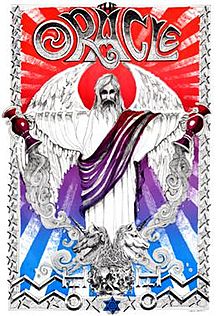San Francisco Oracle facts for kids

Cover of the sixth issue, February 1967
|
|
| Type | underground newspaper |
|---|---|
| Format | Tabloid/Alternative newspaper |
| Founder(s) | Allen Cohen, Michael Bowen, et al. |
| Founded | September 20, 1966 in San Francisco |
| Ceased publication | February 1968 |
| Headquarters | San Francisco, CA |
| Circulation | 125,000 |
The San Francisco Oracle was a special kind of newspaper. It was called an underground newspaper because it was made by people who wanted to share different ideas. It was published in San Francisco from 1966 to 1968.
This newspaper came out 12 times. It was created by people like Allen Cohen, who was the editor, and Michael Bowen, who was the art director. The Oracle was also one of the first members of the Underground Press Syndicate, a group of similar newspapers.
The Oracle was known for its unique style. It mixed poetry, spiritual ideas, and different cultures. It also used a special art style called psychedelic design. This design was full of bright colors and swirling patterns. The newspaper helped shape the counterculture in the Haight-Ashbury area. Many artists and writers contributed to it. These included Bruce Conner, Rick Griffin, Allen Ginsberg, and Gary Snyder.
Contents
The Oracle's Journey: How It Started
The idea for the San Francisco Oracle came from Allen Cohen. Two shop owners, Ron and Jay Thelin, offered to help pay for it. In the summer of 1966, people met in the Haight-Ashbury neighborhood. They wanted to start a new kind of newspaper.
Their first attempt was a paper called P.O. Frisco. It only had one issue. This paper didn't quite work out for everyone involved. So, the Thelin brothers said they would stop funding it unless they tried something completely new.
A New Beginning for the Oracle
A second try began in new offices. This time, the paper was called The San Francisco Oracle. It started with issue number one. At first, it didn't have the famous colorful design it later became known for.
George Tsongas and John Bronson edited the first two issues. Then, Allen Cohen became the main editor. Gabe Katz became the new art editor. They started with issue number three. This is when the Oracle began to look very colorful and unique.
A Challenge for Free Speech
Soon after the new Oracle #3 came out, editor Allen Cohen faced a challenge. He was involved in a case about free speech. This event became well-known across the country. It showed how important the newspaper was in sharing new ideas.
Growing the Team and Moving On
The Oracle quickly built a strong team. Many people helped create the paper. These included Michael Bowen, Stephen Levine, and Travis Rivers. Artists like Dangerfield Ashton and Ami McGill also joined.
After issue #5, the newspaper moved to a new office. This new place was open all day and night. It became a busy hub for creativity.
The Famous Rainbow Colors
Starting with issue #6, the Oracle changed printers. At the new printer, the artists could experiment. They found a way to make a special rainbow effect on the pages. This was done by using different colored inks at the same time.
This made the Oracle very colorful and eye-catching. It was a huge success! The paper had to print more copies because so many people wanted one.
Reaching Many Readers
The newspaper's circulation grew quickly. It started with 3,000 copies. By issue #5, it was printing 50,000 copies. Issue #6 printed 60,000 to 75,000 copies. At its most popular, the Oracle printed about 125,000 copies.
The editors believed that many more people read it. They thought that people shared their copies with friends. This meant the paper reached over half a million readers!
Important Discussions in the Oracle
The Oracle featured many important articles. Issue #6 had a discussion about the Age of Aquarius. Issue #7 brought together famous thinkers like Alan Watts and Allen Ginsberg. They talked about big questions, like "Should we drop out or take over?"
Issue #5 helped launch the Gathering of the Tribes. This big event happened in Golden Gate Park in 1967. The last issue, #12, included a discussion called "2000 A.D." with Alan Watts and other experts.
Other Papers Like the Oracle
After the San Francisco Oracle stopped publishing, other similar papers appeared. Some of the Oracle staff created a paper called the Harbinger in 1968. It also had contributions from Alan Watts and Timothy Leary.
Later, a new Oracle was launched. It was called the San Francisco Oracle of the Spiritual Revolution. This paper focused more on spiritual topics. It was published from 1968 to 1969.
Other cities also had their own "Oracle" papers. For example, Los Angeles had The Oracle of Southern California. Some of the original Oracle team also helped start the San Francisco Express Times. This paper later changed its name to San Francisco Good Times. Students at San Francisco State College even made a funny parody paper called the Orifice!


